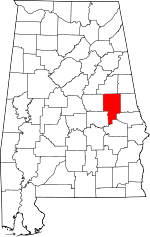Cherokee Bluffs, Alabama
Cherokee Bluffs is an unincorporated community in Tallapoosa County, Alabama, United States. The bluffs were a landmark in Tallapoosa County, and they were chosen as the first site on the Tallapoosa River for the creation of a dam and reservoir.[2]
Cherokee Bluffs, Alabama | |
|---|---|
 Cherokee Bluffs  Cherokee Bluffs | |
| Coordinates: 32°40′55″N 85°54′23″W | |
| Country | United States |
| State | Alabama |
| County | Tallapoosa |
| Elevation | 561 ft (171 m) |
| Time zone | UTC-6 (Central (CST)) |
| • Summer (DST) | UTC-5 (CDT) |
| Area code(s) | 256 & 938 |
| GNIS feature ID | 115998[1] |
Background
Martin Dam was built at Cherokee Bluffs and completed in 1939. During construction, the community had bathhouses, bunkhouses, a school, commissary, dining hall, recreation hall, camp hospital, and a barber shop. The workers were tested for typhoid fever and malaria, and were not hired if they tested positive for malaria. Local residents were also tested for malaria.[3] Cherokee Bluffs is the birthplace of Roy C. Craven, the founding director of the University Gallery at the University of Florida.[4]
References
- "Cherokee Bluffs". Geographic Names Information System. United States Geological Survey.
- "Martin Dam". Alabama Power. Archived from the original on 2012-03-19. Retrieved 2014-06-23.
- Lake Martin, Alabama's Crown Jewel - Elizabeth D. Schafer - Google Books. Books.google.com. Retrieved 2014-06-23.
- Craven, Roy. "A Study of Indian Painting (MA Thesis)". University of Florida. Retrieved 6 December 2013.
